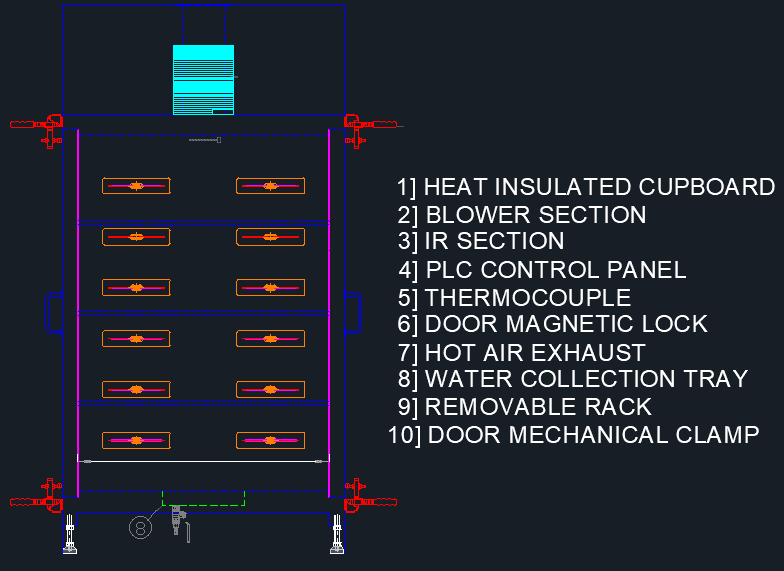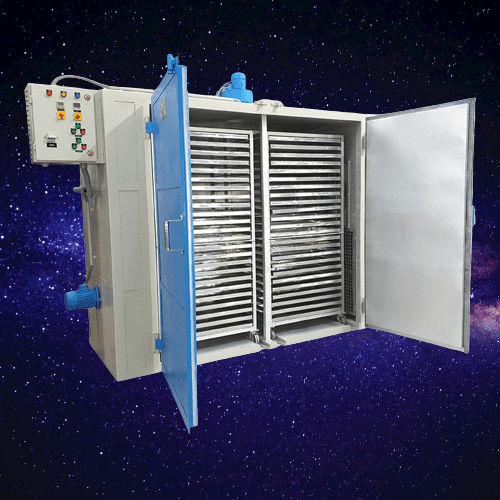Tray dryer in pharma industries is an enclosed, insulated chambers, trays are piled on top of one another in tray dryers, which use conventional drying. The driers are used in industrial manufacturing processes where drying and heating are essential steps, including the production of food goods, pharmaceuticals, dyes, and chemicals, among others. The trays are filled with wet or solid objects that need to be dried. Dryers are used to evaporate or sublimate liquids from bulk solids, powders, components, continuous sheets, or other liquids. The two primary types of dryers are direct and indirect dryers. Direct dryers use heated air, gas, or a gas product that has been burned to convectively heat a product. By contact with a heated wall, a product is conductively heated in indirect dryers.
In a traditional technique, a tray dryer is employed to achieve the greatest drying results. Pharmaceutical equipment ie. tray dryer used to dry the trays. The wet-granulation method is the most popular and all-purpose way to make tablets. Its popularity can be attributed to the higher likelihood that the granulation will satisfy all the physical criteria for the compression of high-quality tablets. The procedure’s main drawbacks include the sheer number of distinct steps required, as well as the time and work required to complete it, especially on a big scale. Weighing, mixing, wet massing, screening the damp mass, drying, dry screening, lubrication, and compression are the steps in the wet method. The amount or size of the batch and the ratio of the active component to the overall weight of the tablets determine the necessary equipment.
Working principle of the Tray dryer:
A stream of hot air in a radiator coil or electric heater transfers the heat via the trays. The blower fans that are installed make it easier for heat to be transferred and to be circulated properly. The apparatus also features a temperature control panel and other factors that are set outside the apparatus and help it function. The constant circulation of hot air serves as the foundation for this amazing device’s operation. By using forced convectional heating, the tray drier removes moisture from the particles that are placed inside of it. The evacuation of the damp air is done partially yet simultaneously.

The trays are initially filled with wet solids and placed in the dryer chambers. Fresh air is then introduced by the inlet and heated by the heaters after passing through them. The fans in the tray drier are employed to circulate the hot air at a speed of two to five meters per second in order to achieve the heating’s goal of making sure that the heated air reaches the wet solids on the tray. The air boundary layers’ thickness and atmospheric partial vapor pressure are both decreased by turbulent airflow.
Water is drawn into the warm air. Water is diffused from the core of the solids by capillary action as water evaporates from the surface. In a single air pass, the aforementioned activities all take place. The discharge air is returned to the fans at a rate of 80 to 90 percent due to the brief contact time and little amount of water that is taken up in a single pass, and only a maximum of 20 percent of fresh air is introduced.
Types of tray dryers in pharmaceutical industries
There are two types of the dryer as following:
1. Vacuum Tray Dryer
2. Atmospheric tray Dryer
- Vacuum tray dryers are excellent for drying goods that are hygroscopic and sensitive to temperature and oxygen. Effective for drying sticky and lumpy items.
Features & Sailent Characteristics of tray dryer :
• cGMP construction with contact parts SS316/SS316L and non-contact SS304.
• Heating shelves with channels for quicker heat transmission rates.
• The ability of online receivers to drain in a Hoover.
• A Hoover suction line with a large diameter reduces choking and maximizes vapour suction
• A single-piece door gasket that prevents leaks.
• Body that is entirely welded.
• Tunnel-style dryers, which allow loading and unloading through a double door and allow trolleys to be stacked one on top of the other.
• Heat exchanger fins that are continuously coiled and crimped in models with steam or thermal fluid heating.
• A steam/thermal fluid heat exchanger was hydraulically tested at 20 Kg/cm2.
• Vacuum pump of the watering variety.
- ATMOSPHERIC TRAY DRYERS
• Solids product drying in chemical, pharmaceutical, specialty chemical, food processing, and other sectors. Before packaging, dry wet bottles and containers.
Features & Sailent Characteristics of tray dryer :
• cGMP construction using SS316/SS316L contact parts and SS304 non-contact parts.
• Heating shelves with channels for quicker heat transmission rates.
• Blower fans of the axial flow type with variable pitch blades that alter airflow to fit the product being dried.
• Tunnel-style dryers, which allow loading and unloading through a double door and allow trolleys to be stacked one on top of the other.
• Explosion flaps, non-sparking metal combinations, earthing chains, etc. in flameproof structure
• Positive exhaust, when necessary.
• Heat exchanger fins that are continuously coiled and crimped in models with steam or thermal fluid heating.
• A steam/thermal fluid heat exchanger was hydraulically tested at 20 Kg/cm2.
• The electric heater connections for dryers that use electricity are situated outside the hot zone. The fans are constructed of AISI 304/316 and are powered by appropriate motors, making heaters accessible and replaceable from outside the dryer.
You may also read about, Technology of Ampoule Filling and Sealing Machines.
Major components:
Construction specifications include:
• Surface Finish:
- EXTERNAL: Matte finish after buffing to 150 grit
- INTERNAL: Mirror finish 220 grit buffing.
- All dryers have a manual infinitely adjustable damper at the exit and a 5-micron pre-filter at the inlet.
Doors are available on the dryer’s front and/or back sides. To stop leaks, door lips are coated with a silicon rubber gasket. There is adequate locking on the doors. - Air Circulation: Inside the dryer, specially-made recirculation blowers circulate the air. The size and model of the dryer affect the blower’s static and dynamic performance.
- Dryers are typically equipped with a heating system that uses steam, electricity, thermo fluid, or hot water. The dryers are equipped with the appropriate heating coils and clarifiers.
- Temperature management is handled via a digital electronic temperature controller installed in the control panel. The dryer’s temperature management is totally automatic.
- Trays are offered in stainless steel types 304 and 316. Every tray has coved corners and is fully die-pressed. Trays have a polished, mirror-like appearance. According to the needs of the customer, trays are also available in aluminum, polypropylene, frap, and m.s. galvanized.
- Trolley: A trolley is available in the dryers to hold trays. The trays are loaded and unloaded into the dryer using trolley trucks.
- Automated Control Panel Control panel is fitted on the side of the dryer. It consists of timers, controllers, push buttons, safety relays, ckt breakers, indication lamps, contactors, and starters.

Material and Construction Details:
The dryer is made of sturdy material and is built on 3 mm thick sheet metal formed into angles and appropriately reinforced with angles and sections. The exterior walls of the dryer are constructed from 1.6mm thick sheets of stainless steel that are grade 304. S.S. 304 grade sheets measuring 1.6 mm thick are used to construct the dryer’s interior. The entire internal structure is TIG welded, and the surfaces of every internal component are smooth. It is clad with SS, Polished sheets, and insulated with glass wool that is at least 50 mm thick. The dryer has a front door, an adjustable air outlet flap, and 20 Micron PP cloth filters for the fresh air inlet. The door is impervious to explosions and is securely fastened with the aid of spring-loaded ball locks. Neoprene rubber gaskets are used on door lips to stop leaks.
Tray Dryer Applications:
Drying foods like chilies, spices, papad, potatoes, onions, fish, garlic, grapes, cashew nuts, confections, macaroni, and wood is appropriate for tray dryers. Moreover, it is used to dry chemicals, plastic granules, powders, pharmaceuticals, and other materials. Electric, steam, or a combination of the two can be used for heating. This booklet includes a list of various models to accommodate customer needs. Requests for quotes for custom-built models will be honored.
Validation and documentation:
Complete documentation and certification traceable to national and international standards:
- MOC / COA certificate of contact and noncontact PARTS.
- MOC food grade and nontoxic certificates of contact and noncontact gaskets
- Electrical diagram
- Sets of maintenance and operational manual
- Functional specification and design specification (FS/DS)
- Calibration certificates of gauges and instruments with traceability certificate
- Operational manual of automated or PLC system / MMI
- Operational & maintenance manuals for the coater.
- Maintenance Manual
- PLC input/output list
- PLC and control panel wiring diagram
- List of alarm and their rectification procedure
- List of functional authorization
- FAT / SAT document
- GA (General alignment) drawing
- Schematic diagram of the machine showing overall dimension (as built drawing)
- System architecture diagram configuration and calibration certificate
- Alarm list (diagnostic and system created)
- FAT and installation qualification protocol
- Flameproof certificate of motor and accessories
- Certificate of HEPA filter and test certificate and certificate of another filter
- P&ID (Piping and instrumentation diagram)
- PLC backup
- Complete set of DQ, and IQ Documents.
- All documents are as per URS
You may also read this book Pharmacist Exam Book
What is Tray dryer?
Answer: Trays are stacked on top of one another in trolleys inside a tray dryer, which is an enclosed, insulated space. Tray dryers are used in manufacturing processes where heating and drying are crucial steps, such as in the production of chemicals, dyes, pharmaceuticals, food products, and colors. The trays are filled with the item to be dried, either wet or solid. Steam in radiator coils or hot air circulated by electric heaters is two ways to transmit heat. To maintain optimal heat transfer and circulation, blower fans are fitted inside. Outside the dryer is a control panel that may be used to adjust the temperature and other settings. These dryers are offered in constructions made of mild steel, stainless steel, or both. Pigments, food, bakery items, electrodes, chemicals, and plastic powders are all dried using trays. The drying ovens are often offered with a selection of heating methods, including electrical, steam, and thermic fluid heating.
A computerized temperature controller and digital timer are included in the electrically heated type to make working day and night easier. Digital temperature indication and a digital timer are included in the steam and thermal fluid heated variant, however, the temperature controller is not included.
Benefits of the Tray Dryer In Pharma
- Because it runs in batch mode, each batch can be treated separately.
- Because it uses less electricity, the dryer is energy efficient.
- It’s easy to clean and utilize.
- Because tray dryers come in a variety of sizes, capital costs can be managed.
- External heating of the chamber walls prevents condensation.
- It has a novel single-chamber and multi-chamber design with the least amount of leakage.
- The tray and shelf have excellent surface contact.
- It is the greatest alternative for drying precious pharmaceutical ingredients like wet lumpy solids and wet cakes in small-scale manufacture.
- All connections are made outside the chamber and it has a sturdy hollow shelf construction.
- Operational parameters are easier to control.
- For drying heat-sensitive goods, tray dryers with Hoover systems may be the best option.
